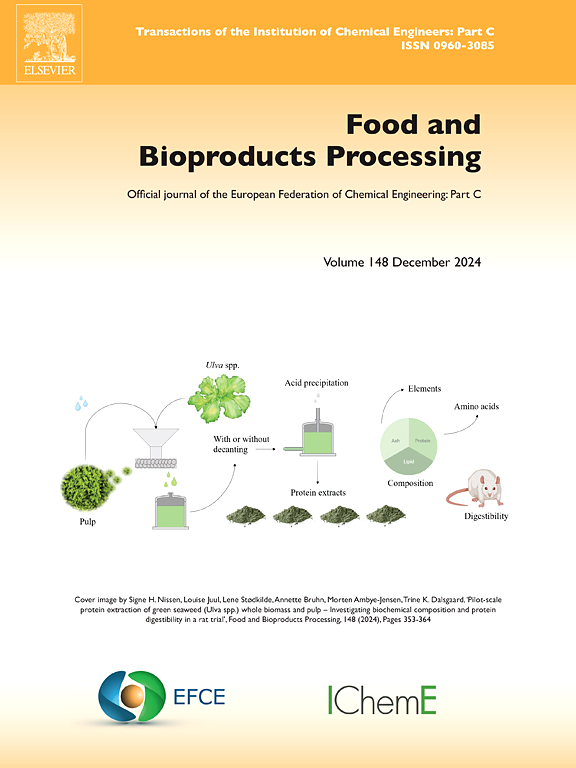Beetroot ketchup as a stable carrier of potential probiotic Lacticaseibacillus rhamnosus K3 and Lactobacillus johnsonii K4: A study on sensory attributes, storage viability, and in vitro gastrointestinal survival
IF 3.5
2区 农林科学
Q2 BIOTECHNOLOGY & APPLIED MICROBIOLOGY
引用次数: 0
Abstract
This research aimed to assess the viability of Lacticaseibacillus rhamnosus K3 and Lactobacillus johnsonii K4 in beetroot ketchup during storage and simulated digestion to examine fermentation effects on sensory quality. The findings revealed that both strains maintained viability above 8 log10 CFU/ml during storage, confirming their potential as probiotics. pH levels changed significantly over three-week storage period indicating fermentation's impact on shelf stability. The control sample maintained consistent pH level of 4.6, while pH of ketchup fermented with L. rhamnosus K3 decreased from 3.84 to 3.79, and ketchup fermented with L. johnsonii K4 decreased from 3.96 to 3.69. Sensory evaluations showed statistically significant differences in odor, texture, flavor, and overall quality between samples. Fermentation with L. johnsonii K4 improved sensory attributes, achieving the highest overall quality score with mean value of 7.31 out of 10, compared to 6.28 for the control and 6.23 for the L. rhamnosus K3 fermented ketchup. Survival rate of L. johnsonii K4 was 27 %, compared to 2.8 % for L. rhamnosus K3 in dynamically simulated gastrointestinal system TIM-1. Both fermented ketchups contained over 109 CFU of viable cells. These results demonstrate that plant-based food products can effectively serve as carriers for potential probiotic strains, preserving their viability during storage and digestion, while enhancing sensory quality of food products.
甜菜根番茄酱作为潜在益生菌鼠李糖乳杆菌 K3 和约翰逊乳杆菌 K4 的稳定载体:感官属性、储存活力和体外胃肠道存活率研究
这项研究旨在评估甜菜根番茄酱中的鼠李糖乳杆菌 K3 和约翰逊乳杆菌 K4 在储存和模拟消化期间的活力,以考察发酵对感官质量的影响。研究结果表明,这两种菌株在贮藏期间的存活率都保持在 8 log10 CFU/ml 以上,证实了它们作为益生菌的潜力。在三周的贮藏期内,pH 值发生了显著变化,表明发酵对货架稳定性产生了影响。对照样品的 pH 值始终保持在 4.6,而用鼠李糖 K3 发酵的番茄酱的 pH 值从 3.84 降至 3.79,用约翰逊酵母 K4 发酵的番茄酱的 pH 值从 3.96 降至 3.69。感官评估显示,不同样品在气味、质地、风味和总体质量方面存在显著的统计学差异。用约翰逊酵母 K4 发酵的番茄酱改善了感官属性,总体质量得分最高,平均值为 7.31(满分 10 分),而对照组为 6.28,鼠李糖 K3 发酵的番茄酱为 6.23。在动态模拟胃肠道系统 TIM-1 中,约翰逊酵母 K4 的存活率为 27%,鼠李糖 K3 的存活率为 2.8%。两种发酵番茄酱都含有超过 109 CFU 的存活细胞。这些结果表明,植物性食品可以有效地作为潜在益生菌株的载体,在储存和消化过程中保持其活力,同时提高食品的感官质量。
本文章由计算机程序翻译,如有差异,请以英文原文为准。
求助全文
约1分钟内获得全文
求助全文
来源期刊

Food and Bioproducts Processing
工程技术-工程:化工
CiteScore
9.70
自引率
4.30%
发文量
115
审稿时长
24 days
期刊介绍:
Official Journal of the European Federation of Chemical Engineering:
Part C
FBP aims to be the principal international journal for publication of high quality, original papers in the branches of engineering and science dedicated to the safe processing of biological products. It is the only journal to exploit the synergy between biotechnology, bioprocessing and food engineering.
Papers showing how research results can be used in engineering design, and accounts of experimental or theoretical research work bringing new perspectives to established principles, highlighting unsolved problems or indicating directions for future research, are particularly welcome. Contributions that deal with new developments in equipment or processes and that can be given quantitative expression are encouraged. The journal is especially interested in papers that extend the boundaries of food and bioproducts processing.
The journal has a strong emphasis on the interface between engineering and food or bioproducts. Papers that are not likely to be published are those:
• Primarily concerned with food formulation
• That use experimental design techniques to obtain response surfaces but gain little insight from them
• That are empirical and ignore established mechanistic models, e.g., empirical drying curves
• That are primarily concerned about sensory evaluation and colour
• Concern the extraction, encapsulation and/or antioxidant activity of a specific biological material without providing insight that could be applied to a similar but different material,
• Containing only chemical analyses of biological materials.
 求助内容:
求助内容: 应助结果提醒方式:
应助结果提醒方式:


